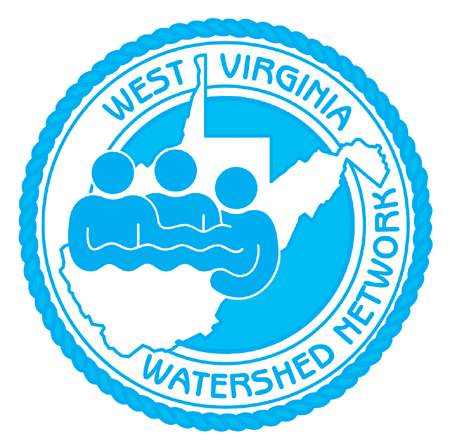 | | WV WaterNet: Winter Edition |
| |
|
| Save the Dates and Upcoming Listening Session |
| | | | | | Meet the Northern Basin AmeriCorps VISTA: Jess Bryzek |
| Jess recently started an AmeriCorps VISTA position working with the WV Department of Environmental Protection Stream Partners Program in the northern basin. As an avid river recreationalist, she was immediately drawn to the VISTA position to work directly with local communities and give back to the rivers that have given her so much: freedom, laughter, inner peace, and memories to last a lifetime. In her new role, she will organize community events, build organizational capacity, and facilitate new partnerships in the West Fork, Buckhannon, and Tygart Rivers in the Monongahela watershed. As she notes, "Adopting a watershed based perspective intertwines rivers and landscapes, as well as our communities into one socio-ecological story." She invites you to join her and dive into your backyard watershed! |
|
|
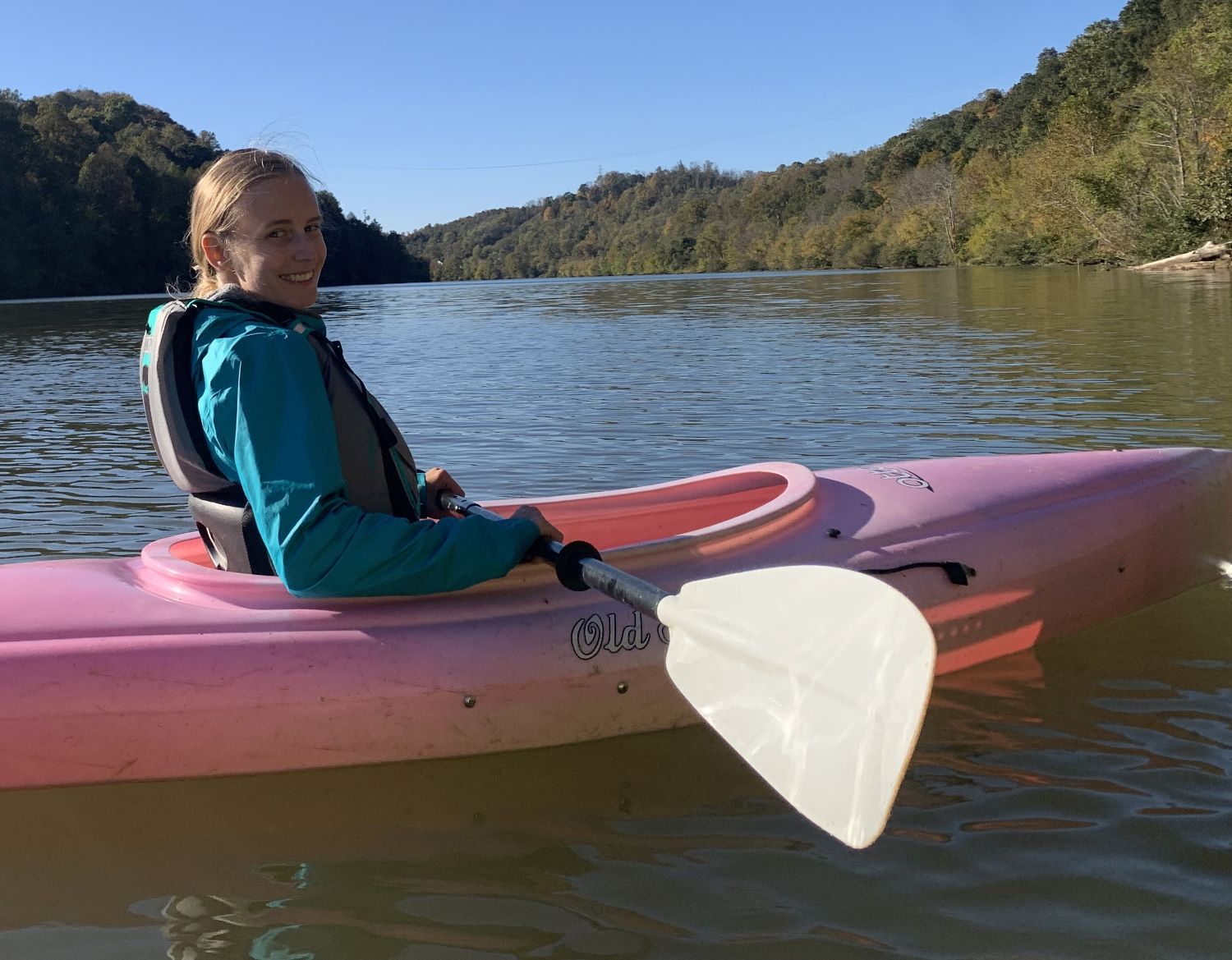 | Jess Bryzek, AmeriCorps VISTA for the Northern Basin, kayaking the Monongahela River. |
|
|
| | Updates from Around the State: Vernal Pool and Save Our Streams Monitoring Workshops, Virtual Social Hours, and Watershed Group Social Media |
| WVDEP & Partners offering Vernal Pool Monitoring Workshops this Spring By: Callie Cronin Sams |
| 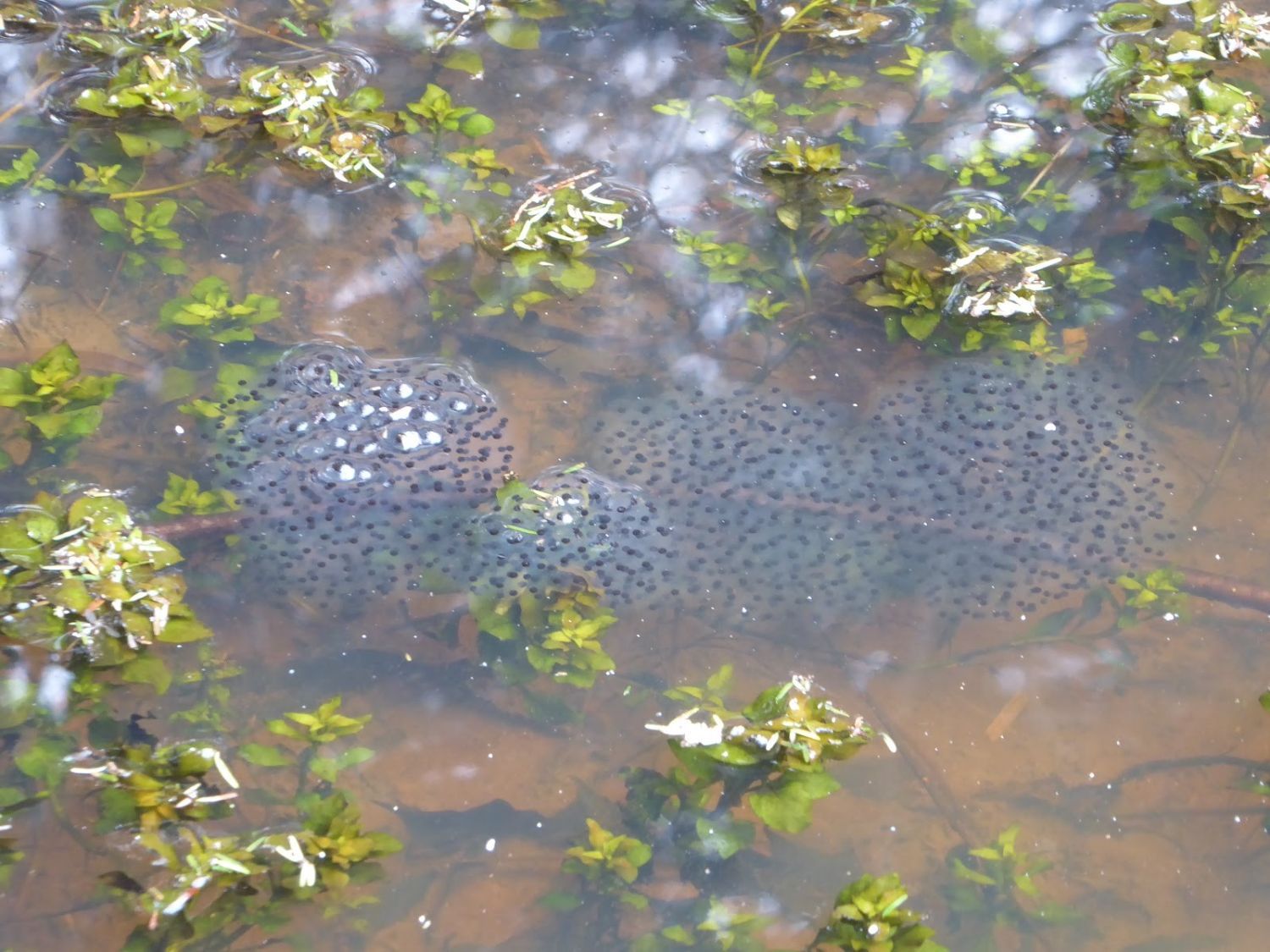 | Wood frog egg mass in a vernal pool. Photo: Elizabeth Byers |
|
|
As spring slowly approaches, gullies and forest depressions are already filling with rain and snow melt creating temporary wetlands known as vernal pools. Soon, forest-dwelling amphibians will spring into action, returning to the pools they emerged from as young to deposit spermatophores and egg masses, spawning the next generation of salamanders, spring peepers, and wood frogs. Vernal pools provide critical habitat for these amphibians, as well as macroinvertebrates, and woodland birds and animals, but are often threatened by development and other human activity. |
|
|
| Join professionals from the WV Dept. of Environmental Protection (WVDEP), WV Division of Natural Resources (WVDNR), and partnering agencies for a vernal pool monitoring workshop to learn about these ephemeral ponds and how you can become a vernal pool monitor. Monitors will visit a vernal pool, or pools, one to three times per year and record observations related to the pool size, characteristics, and whether amphibian egg masses are present. Monitors will submit their data sheet to the WVDEP and upload photos to the WV Vernal Pool Project on the iNaturalist app. As we learn more about where vernal pools are located and the populations they support, we can better protect them by raising public awareness to their importance in the forest ecosystem. |
| Upcoming Vernal Pool Monitoring Workshops: Kanawha State Forest Nature Center
Sunday, March 19, 2023
1:00 - 4:00 PM at the Nature Center and Spotted Salamander Trail
ADA Accessible Workshop Cranberry Mountain Nature Center
Friday, April 14, 2023
11:00 AM - 4:00 PM These workshops are free and open to the public. Register by emailing Callie Cronin Sams at callie.c.sams@wv.gov and be sure to include your name, email address, phone number, and which workshop you plan to attend. If you are associated with a watershed group, Master Naturalist association, or school, please include that information as well. Space is limited, so don’t delay! |
|
|
| | First WV Watershed Group Social Hour A Great Success! |
|
|
| 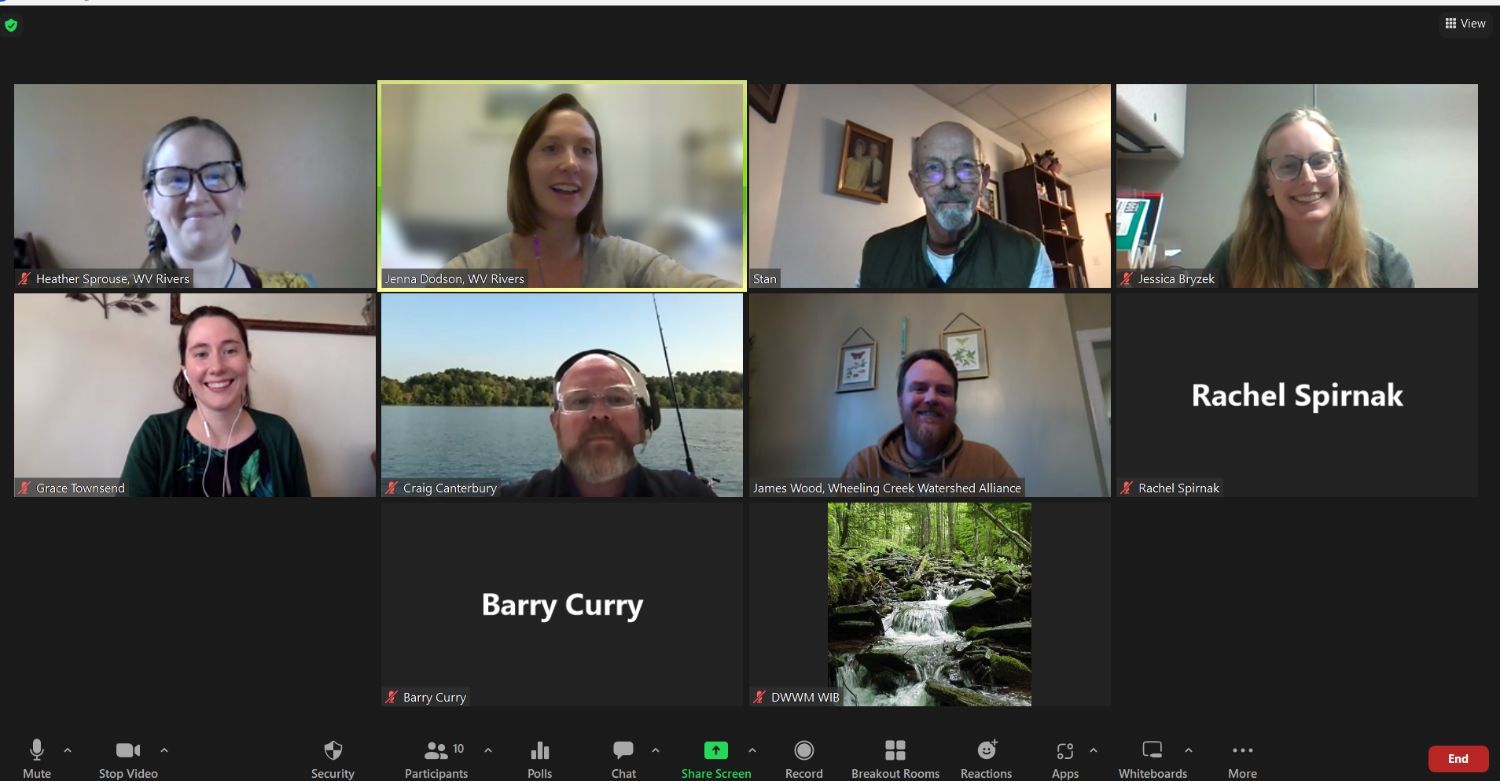 | Group picture from the first WV Watershed Group Virtual Social Hour. |
| On March 2nd, the West Virginia Watershed Network hosted the first WV Watershed Group Virtual Social Hour! With over 10 participants ranging from watershed group members to DEP basin coordinators, it was a great opportunity for folks to connect, ask questions, and share stories and knowledge. Topics discussed included upcoming events, fundraising ideas, water trail maps, and the WV Watershed Group Hub - a map of watershed groups around the state with their contact information. Mark your calendars for the next WV Watershed Group Virtual Social Hour on Thursday, April 6th 4:30-5:30pm. Register here! |
| |
|
| Interested in Hosting a Save Our Streams Workshop? What is Involved? By: Callie Cronin Sams |
| During a WVDEP Save Our Streams workshop, participants learn how to evaluate water quality of wadeable rivers and streams by examining the stream habitat, conducting chemical analyses, and studying the biodiversity of benthic macroinvertebrate communities. The stream habitat assessment evaluates the stream bank, riparian buffer, and substrate conditions. The habitat assessment may also include a pebble count. The chemistry analysis is customized to the stream and watershed, with survey parameters selected based on likely impacts from types of land use in the area. Parameters may include pH, dissolved oxygen, alkalinity, conductivity, turbidity, iron, and more. The physical analysis includes recording the stream water temperature and practicing techniques to measure flow (discharge measured in cubic feet per second), to facilitate pollutant load calculations. The biological assessment surveys macroinvertebrate communities with diversity and abundance factoring into the stream’s biotic index score. |
|
|
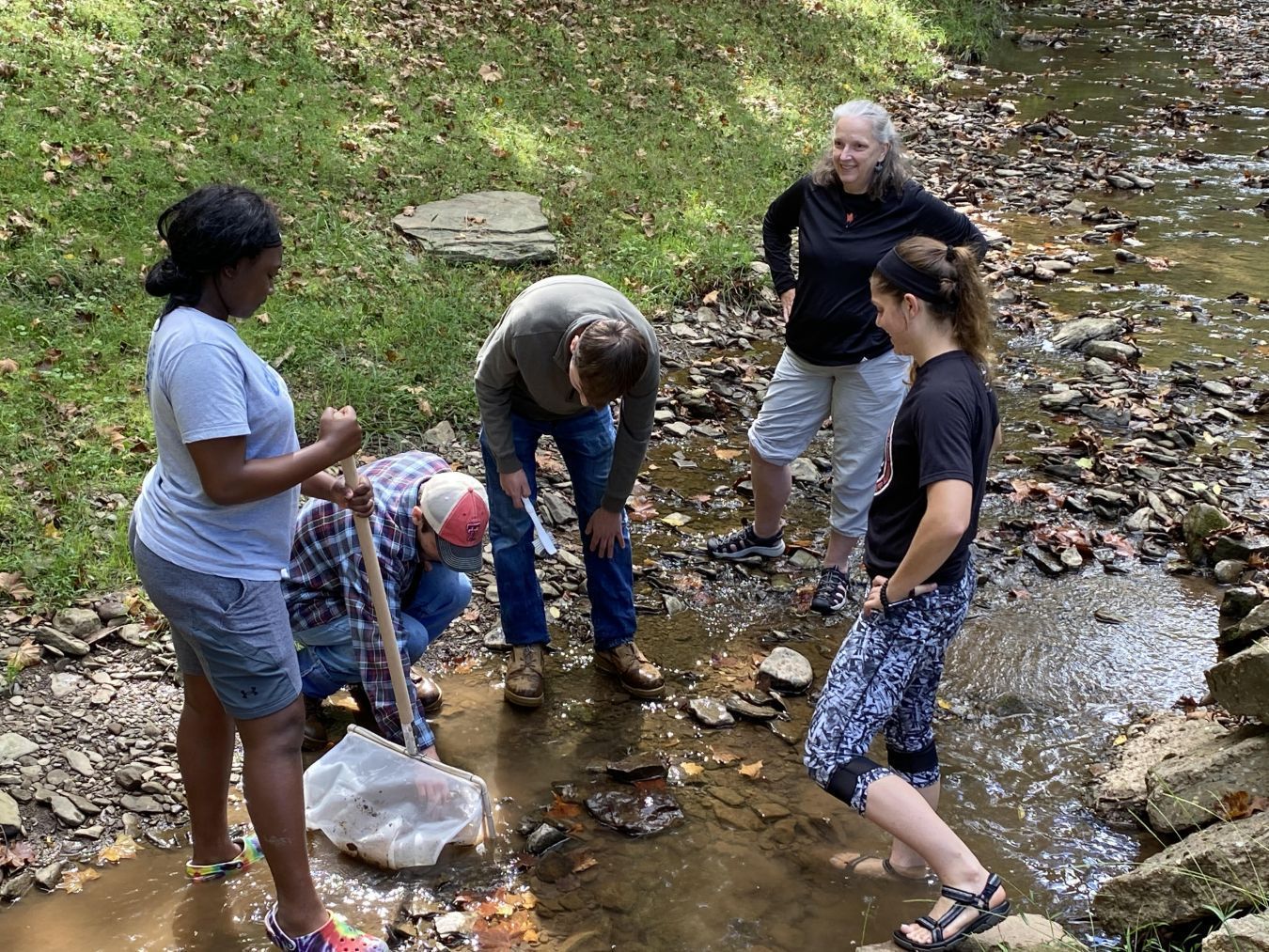 | Workshop participants collecting macroinvetebrates during a Save Our Streams workshop. |
|
|
|
|
| Following the training and completion of the certification exam, monitors enter stream data in the online Volunteer Assessment Database and contribute to our knowledge of the health of our state’s watersheds. Watershed organizations should plan to send out their trained monitors twice a year. In preparation for the workshop, participants should plan to wear clothing appropriate for a day outdoors in and around the water, including muck boots or waders, bug spray, and fast-drying clothing. Participants may spend some time before the workshop looking over the study materials at dep.wv.gov/sos. Would your watershed group like to host a Save Our Streams workshop? Reach out to the program coordinator, Callie Cronin Sams, to discuss details, such as dates, times, and location. Plan to allow 4 - 6 hours for the workshop. |
|
|
| | Watershed Groups in the Social Media Universe By: Martin Christ |
|
|
| This is a great planet and a great universe. There are problems, but let’s not trade them in. Nevertheless, it seems that a whole new universe appeared about 20 years ago: that of social media. Unlike the original universe, you can (maybe) stay out of the social media universe. Like the original universe, however, you can choose to travel widely or stick to your own yard, you can make a big noise or quietly do your thing, and you can just groove on cat videos or study things in detail. I don’t have a Hubble or Webb telescope to look into that universe, so I decided to ask a few watershed groups what they are doing out there. It turns out they are using their brains, learning how the place works through trial and error, and getting results. The groups I talked to, Friends of Blackwater, Friends of the Cheat, and Friends of Deckers Creek, all use Facebook and Instagram. They also have YouTube and Twitter accounts, but use them less. They also all have accounts with email senders, such as MailChimp, which keeps track of email addresses, sends emails to them, lets people subscribe and unsubscribe, and responds in some way if those emails bounce. The groups use social media to get the word out, whatever that word is. Some common posts are about events, news, successes, and natural history. All of it is easier than what people did in the old universe, where we had to drive to the grocery store to tape up flyers and fax things to the newspaper in just the right format. |
| 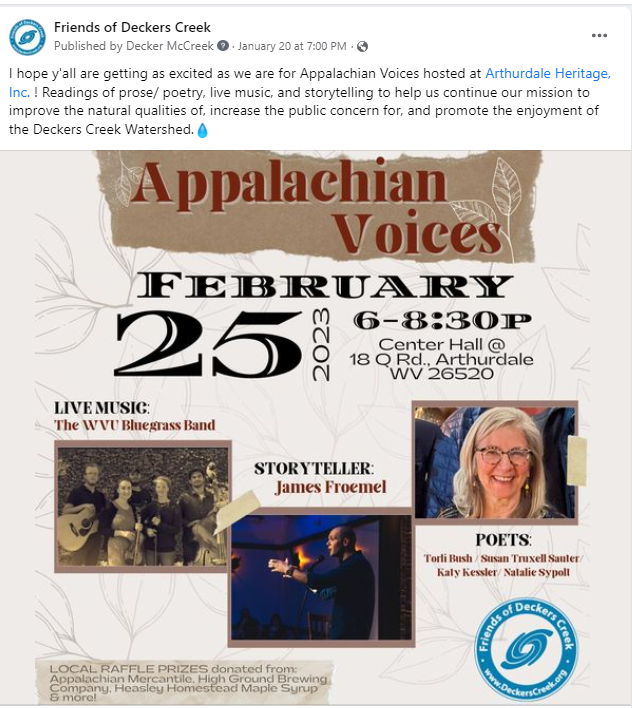 | A Friends of Deckers Creek post for an event that included storytelling, live music, and a poetry reading. |
| Social media, especially Facebook and Instagram, track statistics for every single post. If you are the manager of a group, you can see these statistics. On Facebook, one is “reach,” which is the number of people Facebook presents your post to. Your reach goes higher the more people follow you or comment on or share your posts, but it is also affected by other things, such as timing. Friends of Blackwater has found that if you want a good reach during the heavy viewing hours at the end of the day, it’s best to post sometime in the afternoon. A morning post may be completely overwhelmed by the traffic of the day by that time! Other statistics are “shares,” and “engagement.” If someone shares your post to friends or the public, you chalk one up in the share column. If someone posts a like (or a love, a care, a haha, a wow, a sad, or an angry) or makes a comment, then that post has post-engagement activity. One more statistic is the number of people who have joined or follow your group. All three Friends groups are increasing their numbers of followers and increasing the reach of their posts, even though there are different strategies. While one group has a goal of two to five posts a week (many of which are interesting plants or animals from their watershed), another group is worried about too many posts becoming “scrollable,” meaning just too easy to pass by while looking for more attention-grabbing content. All the groups agreed, however, that the magic is in the quality of the posts, not the exact schedule of posts. A pretty landscape or a smiling friend are more likely to get likes and shares than a written message or a cluttered map. More than one group mentioned using other programs to compose posts before plunking them into social media. Canva (canva.com) for example, provides templates especially for Facebook and Instagram posts, so that they come out with the correct size and resolution. Friends of Blackwater embeds YouTube videos in their Facebook posts and has found many fans of waterfalls and salamanders in the Blackwater watershed. |
| 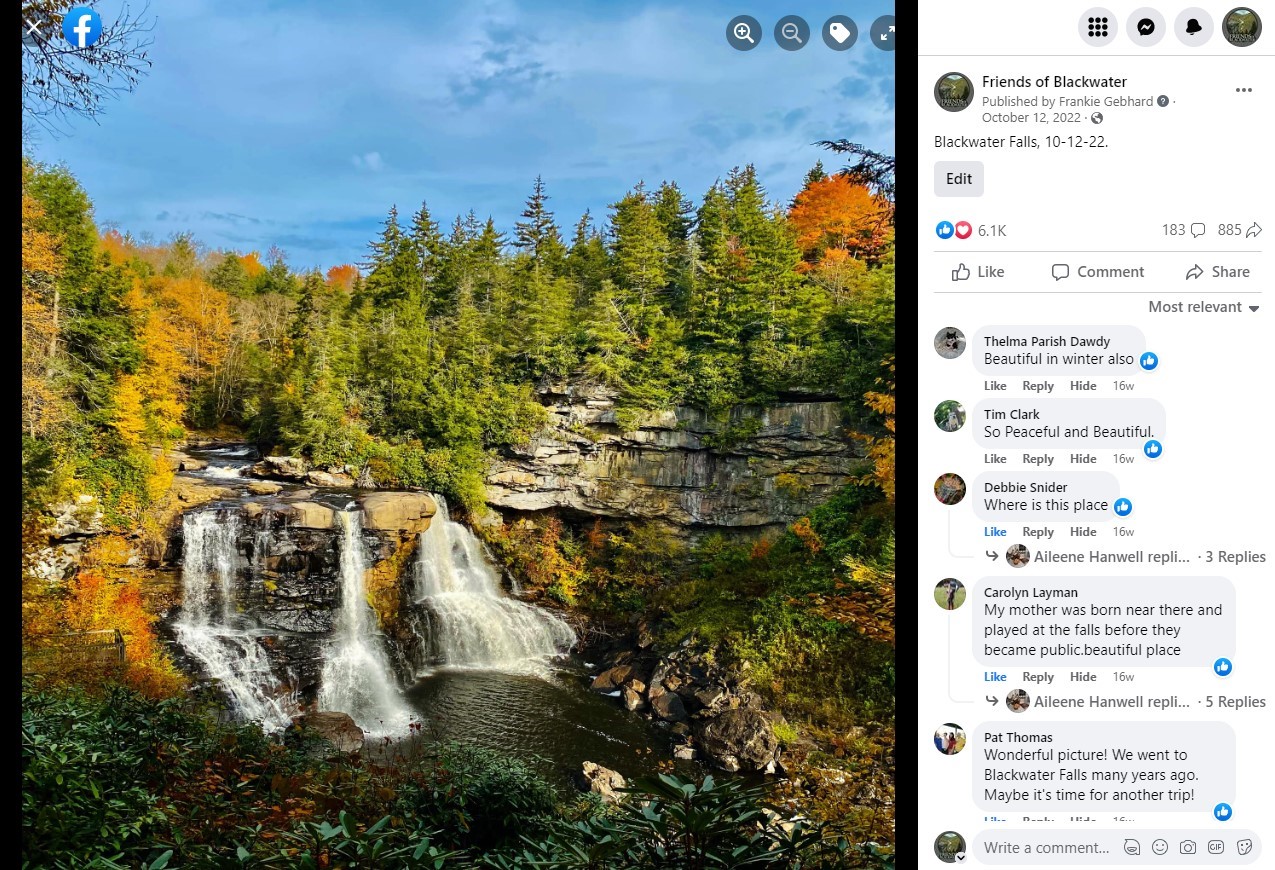 | A Friends of Blackwater post with bright, blue-sky pictures of Blackwater Falls was a big hit. |
| Pictures of people carrying out the mission of the organization get a lot of engagement, and the organizations are confident that those posts are making more people realize what the organizations are all about. In general, the groups posted more about an event the more important it is. CheatFest, Friends of the Cheat’s annual festival along the river in Albright, WV (May 5 and 6) will get a lot of posts, and even individual parts of it–the silent auction, the music line-up, the Education Eddy, have gotten their own series of posts in the past. Friends of Deckers Creek has a Two and One posting strategy. They post two months out, one month out, two weeks out, one week out, two days out, one day out. None of the groups reported a serious problem with trolling. Sarcastic, negative comments that are barely on topic occur seldom to never. The groups have dealt with them mostly by ignoring them, rather than deleting them. They rarely block anyone. The groups have used some tricks to extend their reach and get information out to even wider groups. One trick is tagging other groups they work with. The supporters of those groups then have the opportunity to engage with, and possibly follow, the watershed group. The platforms allow you to add six targeting tags to your post, and that will increase your reach to those interested in those tags. For a fee, the platforms will boost your post and increase their reach. The groups have all tried this, but seem to be dedicated to extending their reach mostly through good content. |
| |
|
| | West Virginia Rivers Coalition
3501 MacCorkle Ave SE #129 | Charleston, West Virginia 25304
304-637-7201 | wvrivers@wvrivers.org |
| The WV WaterNet is made possible through an award of Environmental Protection Agency’s 319 funding awarded to the West Virginia Rivers Coalition by the West Virginia Department of Environmental Protection. |
|  | |
|
| |
|
|